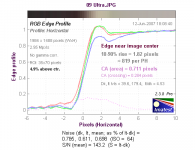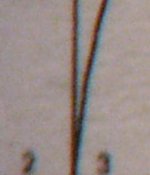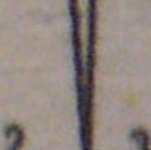Surveyor
The more I understand, the more I understand why I
I've tried to photograph the longitudinal CA ............
Henry
Henry,
I think that measuring longitudal CA would be extremely difficult. Since the CA would fall in front of, or behind the image plane, and by a distance that would be well within the depth of field of low power instruments that, when viewing axially, would have insufficient defocus to see. Plus, a color may obscure another. I find that I can very seldom get to where I see fringing all the way around (longitudal) the target, usually just in one direction.
You may be able to do it by using a very small dot or cross at as close a distance as you can focus on (minimum depth of field), placing the optical axis of the optic on that spot, then boosting the daylights out of it. You may get enough defocus of the longitudal error that way to tell something about it.
I have done some lateral CA measurements along with the MTF stuff and find the optical axis/target alignment quite critical. You also have to choose your white for consistency (illuminant A will have more red than D65) and be sure to use the same illuminant and intensity for the tests so as to make sure you have the same levels of red, blue and green. Attached is an old test of an Ultravid. I missed the optical axis 5% above, but since using a vertical line, I kept it, but it is not good enough to use as comparison data because I did not use a reference light source. I captured this data while doing comparison MTF’s for a group of bino’s.
If we were to standardize the light source and do a better job of aligning the axis, pictures, such as posted in the 7x36 ED2 posts showing some fringing on the concentric rings at (one degree increments) from the center might make a useful transverse CA comparison tool. Though not on optical axis, note 3 degree left of center and 3 degree right of center of the two crops.
Different light levels, colors, magnifications, backgrounds, viewers’ eyes, front lit, back lit, etc. make visual perception comparisons of CA pretty vague except for present, or not present, IMO.
FWIW, CA just does not bother me, so I spend little time trying to measure it.
Attachments
Last edited:







